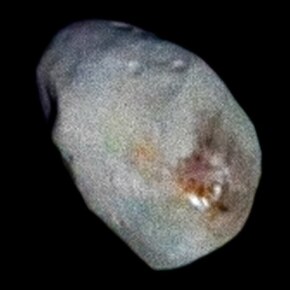
Back Nix (maan) Afrikaans Nix (Mond) ALS Nicte (satelite) AN نيكس Arabic نیکس (اویدو) AZB Нікс (спадарожнік Плутона) Byelorussian Нікс (спадарожнік) BE-X-OLD Никта (спътник) Bulgarian Nix Breton Nix (satèl·lit) Catalan
 Enhanced color image of Nix, taken by New Horizons | |
| Discovery[1] | |
|---|---|
| Discovered by | Hal A. Weaver et al.[a] |
| Discovery date | 15 May 2005 |
| Designations | |
Designation | Pluto II[1] |
| Pronunciation | /ˈnɪks/ |
Named after | Nyx |
| S/2005 P 2 | |
| Adjectives | Nictian (/ˈnɪktiən/) |
| Orbital characteristics[2] | |
| 48694±3 km | |
| Eccentricity | 0.002036±0.000050 |
| 24.85463±0.00003 d | |
| Inclination | 0.133°±0.008° (122.53°±0.008° to Pluto's orbit) |
| Satellite of | Pluto |
| Physical characteristics | |
| Dimensions | 49.8 × 33.2 × 31.1 km[3] (Geometric mean of 37 km) |
| Mass | (2.60±0.52)×1016 kg[4]: 10 |
Mean density | 1.031±0.204 g/cm3[4]: 10 |
| ≈ 0.0028 m/s2 at longest axis to ≈ 0.0072 m/s2 at poles | |
| ≈ 0.0118 km/s at longest axis to ≈ 0.0149 km/s at poles | |
| 1.829±0.009 d[5]: 3 chaotic[6] (decreased by 10% between discovery and flyby)[7] | |
| 123°±10° (to Pluto–Charon orbit)[8]: 11 48°±10° (to celestial equator)[b] | |
North pole right ascension | 350°±10°[5]: 3 |
North pole declination | 42°±10°[5]: 3 |
| Albedo | 0.56±0.05[5]: 3 |
| 23.38–23.7 (measured)[9] | |
| 8.28[5]: 2 | |
Nix is a natural satellite of Pluto, with a diameter of 49.8 km (30.9 mi) across its longest dimension.[3] It was discovered along with Pluto's outermost moon Hydra on 15 May 2005 by astronomers using the Hubble Space Telescope,[1] and was named after Nyx, the Greek goddess of the night.[10] Nix is the third moon of Pluto by distance, orbiting between the moons Styx and Kerberos.[11]
Nix was imaged along with Pluto and its other moons by the New Horizons spacecraft as it flew by the Pluto system in July 2015.[12] Images from the New Horizons spacecraft reveal a large reddish area on Nix that is likely an impact crater.[13]
- ^ a b c d "Planet and Satellite Names and Discoverers". Gazetteer of Planetary Nomenclature. International Astronomical Union (IAU) Working Group for Planetary System Nomenclature (WGPSN). Retrieved 17 May 2021.
- ^ Showalter, M. R.; Hamilton, D. P. (3 June 2015). "Resonant interactions and chaotic rotation of Pluto's small moons". Nature. 522 (7554): 45–49. Bibcode:2015Natur.522...45S. doi:10.1038/nature14469. PMID 26040889. S2CID 205243819.
- ^ a b Cite error: The named reference
phasecurveswas invoked but never defined (see the help page). - ^ a b Cite error: The named reference
Porter2023was invoked but never defined (see the help page). - ^ a b c d e f Cite error: The named reference
Weaver2016was invoked but never defined (see the help page). - ^ Northon, Karen (3 June 2015). "NASA's Hubble Finds Pluto's Moons Tumbling in Absolute Chaos".
- ^ Lakdawalla, Emily. "DPS 2015: Pluto's small moons Styx, Nix, Kerberos, and Hydra [UPDATED]". www.planetary.org. Archived from the original on 27 September 2017. Retrieved 14 November 2015.
- ^ Cite error: The named reference
Weaver2016-suppwas invoked but never defined (see the help page). - ^ Cite error: The named reference
Stern06bwas invoked but never defined (see the help page). - ^ Cite error: The named reference
plutomoonswas invoked but never defined (see the help page). - ^ Cite error: The named reference
scimag000was invoked but never defined (see the help page). - ^ Cain, Fraser (3 September 2015). "Pluto's Moon Nix". www.universetoday.com. Retrieved 26 February 2019.
- ^ Cite error: The named reference
SimonPort2015was invoked but never defined (see the help page).
Cite error: There are <ref group=lower-alpha> tags or {{efn}} templates on this page, but the references will not show without a {{reflist|group=lower-alpha}} template or {{notelist}} template (see the help page).